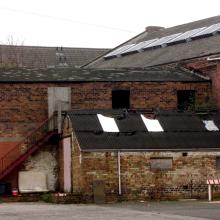
Consent has now been granted for development of a vacant site on Beaverhall Road (Breaking news, 6.3.13; Ref. 11/03374/FUL). But it may surprise some to learn that the area has historical significance.
In November 2011, the city’s curator of archaeology John Lawson wrote to the Planning Department. He suggested there might be three important survivors here of late Victorian and early 20th-century industrial development: two adjoining brick warehouse / workshops in the SE corner (pictured above) and the small brick office at the entrance to the car park (below), along with the site’s boundary walls.
Beaverhall Road was established in the 1880s on land once part of the 18th-century Beaverhall House estate. It had been developed by the time of the 2nd edition Ordnance Survey map of 1896.
Similar archaeological concerns applied to Royal Bank of Scotland's PAN plans for a seemingly undistinguished site at 7, 11–13 Eyre Terrace in 2011 (Issue 202).
Can readers suggest any other architectural diamonds in the rough around Broughton? Contact us by email: spurtle@hotmail.co.uk Twitter: @theSpurtle Facebook: Broughton Spurtle
____________
Reaction on Facebook
